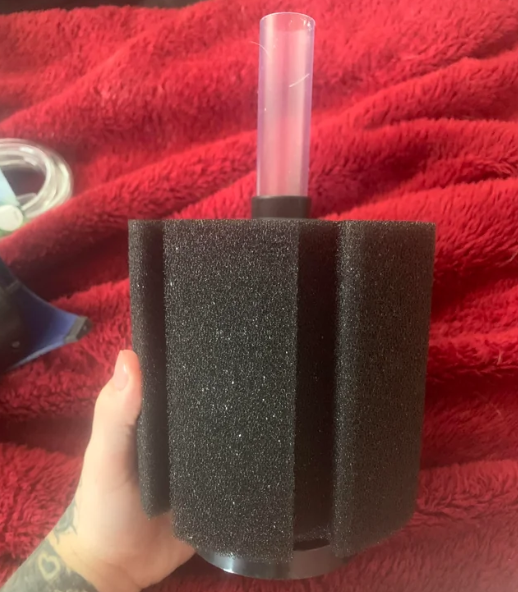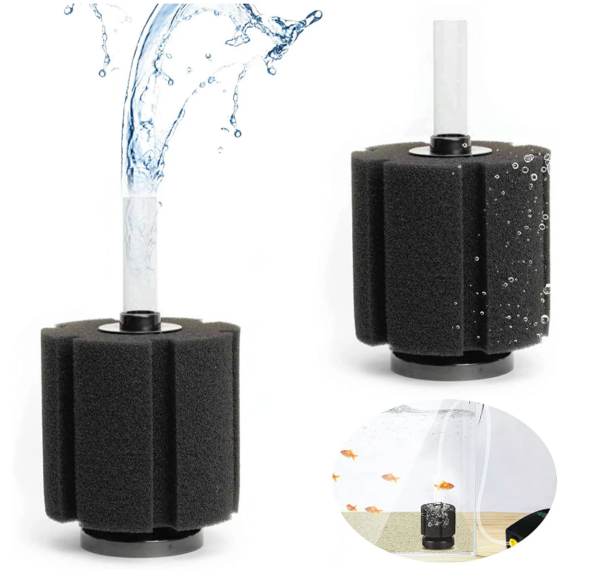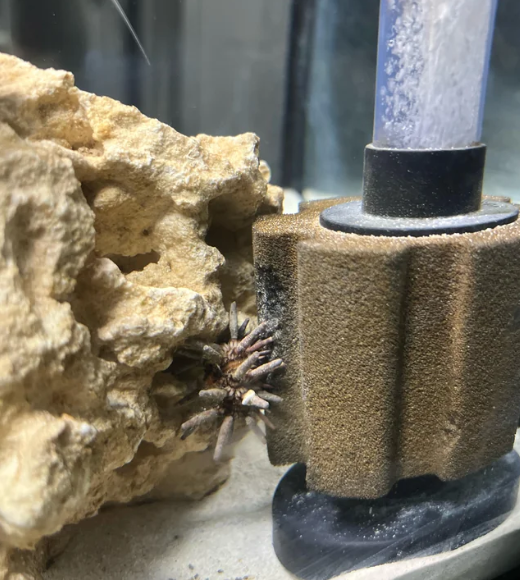In the natural waters, flowing streams, the substrates, and the plants cater to the filtration needs of the inhabitants. In small artificial waters, like your fish tank, it becomes a virtually impossible process due to the absence of a regular flow and lack of space for each individual fish.
Therefore, artificial filters are employed to sustain the health of the aquariums and, moreover, to delay and support the water change routines. While tens of filter types and hundreds of products flood the market, a few of them are more prominent than the others.
Canister filters, HOB filters, SUMP, protein skimmers, internal filters, undergravel filters, and sponge filters are the most common and popular ones. Most others are either a combination of these or are the results of marketing strategies.
Despite being one of the cheapest filter types, sponge filters are very effective for smaller aquariums. In this article, we’ll discuss what they are, their work mechanism, and look at a few products.
Table of Contents
What is a Sponge Filter?
An aquarium sponge filter is the most basic type of filter that requires a sponge, an air pump, and a tubing to function. Thanks to the absence of any major mechanical parts, it seldom causes trouble or stops working.
However, sponge filters are only strong enough to filter uneaten fish food and fish poop. They can’t draw heavier material, such as heavy metals and large debris, to them. Most aquarists use sponge filters by pairing them with a more powerful filtration system.
But, why don’t they disregard the sponge filter altogether?
Because it promotes the growth of beneficial bacteria colonies.
When the other filters fail to sustain their external bacteria colonies growing in their filter floss or ceramic beads during power outages, sponge filters support the colonies by continuously supplying oxygen-rich water.
Adding to the fact that even a low-wattage pump can operate sponge filters, they also can be operated with a less-powered rechargeable battery pump during outages.
Also Read: Filter Flow Rate Guide.
Work Mechanism of Sponge Filters
Sponge filters employ a similar principle as any other mechanical filter. It cycles water through its sponge and delivers fresh, debris-free water back to the tank. However, the difference lies in the way it creates the suction.
Air is pushed by the air pump into the hollow cavity of the sponge filter to create a suction, which draws water from the neighboring areas through the sponge walls. This process mechanically filters debris and allows the beneficial bacteria to grow.
The in-built bubbling mechanism of most sponge filters, however, creates larger bubbles. Thus, aquarists prefer replacing it with an air stone to reduce noise and make the filtration process more efficient.
Sponge filters are particularly effective in tanks with smaller fish and crustaceans. They create suction powerful enough to filter their light bioload, but not capable enough to suck the fish in.
How to Choose a Sponge Filter
You need to remember a few things before buying a sponge filter. Some of them include,
1. Tank Size
If your tank is larger, you need to choose a bigger sponge filter or multiple ones. The sponge filter type may also need to be changed depending on the characteristics of your tank. You need to get different sponge filters for your fish tank, hydroponic tank, or planted tank.
We generally recommend,
Nano sponge filters for 5-gallon tanks
Small sponge filters for 10-gallon tanks
Medium Sponge filters for 20-gallon tanks
Large sponge filters for 40-gallon tanks
Also Read: 5 Best 50 Gallon Fish Tanks.
2. Bioload
A high-bioload fish is a messy eater and poops a lot. The general recommendations mentioned above are considered for average bioload community tanks. But, if you’re keeping high-bioload fish, such as fancy Goldfish or Arowana, you need to get a bigger sponge filter or multiple units of them. Some sponge filters also come with ceramic balls for better biofiltration.
Some common high bioload fish are:
- Goldfish (Carassius auratus)
- Koi (Cyprinus carpio)
- Oscar (Astronotus ocellatus)
- Arowana (Osteoglossum spp.)
- Cichlids (Various species)
- Plecostomus (Hypostomus spp.)
- Red-bellied Piranha (Pygocentrus nattereri)
- Tinfoil Barb (Barbonymus schwanenfeldii)
- Large Catfish (Various species)
- Archerfish (Toxotes spp.)
3. Aeration Needs
Sponge filters not only provide bio-mechanical filtration to your tank but also aerate the water through the bubbles and the sponge. Some fish species, such as Dwarf Gouramis and Loaches, require more dissolved oxygen to survive and thrive.
For them, a more efficient sponge filter is required that can generate denser and smaller bubbles. Air stones can also be a great addition to tanks with these kinds of fish species.
4. Sponge Pore Size
When we say filtration, we expect the sponge to “trap” the debris, and not filter them out in the tank again. Different sizes of sponge pores trap different types of debris. A sponge with larger pores will trap larger debris, and a sponge with smaller pores will trap smaller debris.
Therefore, depending on your requirements and other filtration systems in your aquarium, choose the sponge pore size accordingly.
5. Noise Level
While sponge filters are one of the most silent filters, the bubbles can cause significant noise. Use air stones in your sponge filter to reduce noise and increase efficiency.
6. Sponge Material Quality
Check the quality of the sponge material. High-quality sponges are durable and won’t deteriorate quickly. They’ll also maintain their filtration capabilities for an extended period.
Also Read: 5 Filter Types And Their Uses In Planted Tanks.
How to Setup a Sponge Filter
It’s quite straightforward to set up a sponge filter. Most of the products in this category come with a heavier bottom plate for stability and anchoring.
Pump water into the sponge by squeezing and releasing it with your hands. Otherwise, trapped air may restrict it from submerging.
Plant the bottom into the substrate and connect the air pump to the filter nozzle with air tubes.
If you’re using a third-party air stone, connect it to the tubing and place the stone into the hollow cavity of the filter.
Start the air pump and see if there’s any air leakage from the joint. If you see air leaking, reduce airflow or redo the joining.
Maintaining a Sponge Filter
Sponge filters are also very effortless to maintain.
Step 0: Prepare two buckets. One dry and one with aquarium water.
Step 1: Remove the tubings.
Step 2: Slowly take out the filter, including the sponge.
Step 3: Squeeze the sponge lightly to remove as much dirty water as possible.
Step 4: Rinse the sponge in the aquarium water and place it back into the tank.
Step 5: Connect the tubings.
If you need to replace the sponge, do it in between.
For more complex products with bio-media, rinse them too, and if required, replace them.
Benefits of Having a Sponge Filter
A few benefits of sponge filters are discussed in this section.
1. Biological FIltration
The sponge in the sponge filter offers a large surface area for the beneficial bacteria to colonize. These bacteria colonies break down toxic ammonia into nitrate and nitrite, which are less harmful to fish and plants.
2. Gentle Water Flow
The gentle water flow from the sponge filters is suitable for aquatic species native to slow-moving or still-water environments. The gentle flow is less likely to stress or disturb the fish.
3. Safe for Fragile Fish
Sponge filters are well-suited for tanks with small fish, shrimps, and fry. The suction generated in these filters isn’t capable of trapping or harming them, making them a safe choice for delicate fish.
4. Aeration
Aeration demands are also fulfilled by the sponge filters. Where most external filtration systems introduce minimal to zero oxygen into the tank, a sponge filter consistently keeps on infusing oxygen into the water
5. Low Maintenance
Owing to minimum mechanical parts and filter media, maintenance requirements for sponge filters are pretty low. Just give the sponge a little squeeze every few weeks.
6. Quiet Operation
Although some noise may be present, sponge filters are relatively quieter than other motor-powered filters.
Check out our article on ‘Lily Pipes‘.
Drawbacks of Sponge Filters
As an aquarist, you should be aware of the limitations of sponge filters. Some of them are:
1. Limited Mechanical Filtration
Due to low suction power and lack of adequate filter media, mechanical filtration offered by sponge filters is quite limited. Sponge filters can’t fulfill the filtration demand of high-bioload tanks adequately.
2. Bulky Design
Most sponge filters are bulky in size and shape. They’re not very aesthetically pleasing to keep in aquariums.
3. Zero Chemical Filtration
Chemical filtration is absent in sponge filters. While it provides bio-mechanical filtration to an extent, it doesn’t adsorb phosphate and heavy metals as carbon-activated filter media does.
4. Airline Clogs
Algae and organic debris can clog the airlines to deem the sponge filter inoperable. Regular maintenance is required to keep them operating.
Review of Our Favorite Sponge Filters
1. Hygger Aquarium Double Sponge Filter

| Item | Specification |
| Dimensions | Outside: 6.3 x 2.1 x 9 inchesSponge inside diameter: 0.59 inch |
| Filter Type | Modern sponge filter with ceramic balls. Double filter. Suction cups. |
| Suitable Tank Size | 15 to 55 gallons |
| Working Principle | Mechanical filtration through sponge. Biological filtration through ceramic balls. |
| Sponge Specifications | 60 ppi fine |
| Ceramic balls | 2 containers. 1 bag of balls included. |
| Air tube size | 4mm or 0.16” air tubing. |
The Hygger Aquarium Double Sponge Filter system, suitable for tanks up to 60 gallons, offers mechanical and biofiltration to keep your aquarium crystal clear. The ceramic balls provide additional space for the beneficial bacteria to colonize and feed.
Pros
- Detachable sponges
- Added ceramic balls for better filtration
- Suitable for both saltwater and freshwater aquariums
Cons
- Costlier than traditional sponge filters
2. AQUAPAPA Bio Sponge Filter

| Item | Specification |
| Number of units | 3 units |
| Dimensions | Outside: 4.5 x 4.5 x 8.0 inches |
| Filter Type | Traditional sponge filter. Air pump connector. Suction cups. |
| Suitable Tank Size | 60 gallons |
| Working Principle | Mechanical and biological filtration through the sponge. |
| Sponge Specifications | 60 ppi fine |
| Ceramic balls | NA |
| Air tube size | 0.8” air tubing. |
This versatile AQUAPAPA Bio Sponge filtration system offers a combination of mechanical and biological filtration for both fresh and saltwater tanks. Its air infusion chamber generates countless tiny bubbles, promoting efficient gas exchange and providing effective filtration to your aquarium.
Pros
- Cost-effective and pretty durable
- Low maintenance and less noisy
- Large enough for 30-60 gallon aquariums
Cons
- Less than adequate biological and chemical filtration
FAQs
When choosing a sponge filter, consider your tank size, bioload, aeration requirements, sponge pore size, and customer feedback.
Connect the filter to an air pump and place it on the substrate at the bottom. You could also use an air stone for more efficient filtration.
The 3 types of aquarium filters are mechanical filters, biological filters, and chemical filters.
Typically it doesn’t matter where the sponge filter is placed. However, if you’re using multiple units in a single tank, it’s better to consider their placement.
The Bottom Line
In this article, we’ve discussed the mechanism of sponge filters and how to choose the right one. We also have reviewed a pair of products that we find amazing. Hopefully, you’ll now be able to buy and maintain your sponge filter without any issues.
No related posts.



